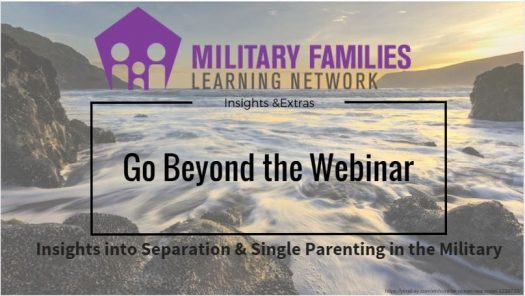By: Bari Sobelson & Molly Herndon

On July 10, 2018, the MFLN’s Personal Finance and Family Development concentration areas hosted the first webinar of a three-part Family Finances Series. Personal Finance’s Project Director, Dr. Martie Gillen and Family Development’s Project Director, Dr. Kacy Mixon, joined forces to facilitate a conversation on separation and single parenting in the military.
There were quite a few insights gained through this engaging and informative webinar that we thought we’d share in this blog. We also gathered some great resources from our team members and webinar participants that you will find in this blog as well!
Insights
- 40.5% of the total force has children– DoD military personnel includes both Active Duty and Selected Reserve members
- The Air Force has the largest number of dual-military marriage families with children
- Family Care Plan– This is a plan put in place when an active duty service member, who is also a parent, becomes a single parent due to various circumstances including divorce, widowhood, spouse missing in action, etc.). The Family Care Plan is mandatory and can result in immediate discharge if not completed. Plans entail short-term providers, long-term providers, and care provision details in the event of deployment, relocation, or reassignment. It is important to take financial considerations into account when creating a Family Care Plan by assessing the financial hardships acquired through relocation of a child, transportation of their belongings to and from caregivers, loss of leave time, etc.
- 3.5% of enlisted personnel and 1.6% of officers were estimated to have divorced and 2.6% of Selected Reserve enlisted personnel and 1.7% of Selected Reserve Officers are estimated to have divorced. Divorce rates tend to be lower for enlisted men and higher for enlisted women compared to civilians while Veterans across genders have higher divorce rates than civilians.
- The Service Members Civil Relief Act is in place to postpone civil court matters due to deployment or reassignment, up to 90 days. Judges can grant additional 90 day stays, dependent upon the length of time the service member will be away on deployment. These proceedings include actions for divorce, child paternity and support cases, and foreclosure proceedings. This protection does not apply to criminal court proceedings.
- Determined by the Defense Finance Accounting Services, there are rules around divorcing couples and entitlement shares to military retired pay. The Uniformed Services Former Spouse Protection Act is a federal law that provides certain benefits to former spouses of military members.
- The 10/10 Rule: 10 years married and 10 years of service before former spouse is entitled to his or her share of military retirement pay
- The 20/20/15 Rule: 20 years married, 20 years of service, and the period of the marriage overlapped the period of service by at least 15 years
- The 20/20/20 Rule: 20 years married, 20 years of service, and over a period of 20 years; providers not only share of military retirement pay but also medical, commissary, and exchange privileges, as long as the former spouse remains unmarried
- Basic Do’s and Don’ts of Divorce
- Do stay well informed before the divorce
- Don’t fall into the silent partner syndrome
- Do hire your own team
- Don’t keep any joint accounts or co-signed loans
- Do protect child support and alimony payment
- Emotions/Struggles affect behavior and those connected to separation and single parent scenarios can make financial decisions difficult and stressful.
- When working with families around finances and separation and single parenting, there are surface behaviors that may arise including mental fog, inattention to detail, procrastination, lack of follow through, crying, and indifference, and many more.
- Ambiguous Loss is a loss that occurs when someone is unable to get closure or understanding. This may be experienced by family members dealing with separation and single parenting.
- These emotions/struggles and surface behaviors can create barriers to the services you are trying to provide and can sometimes even prevent services from being effective. But, “if you are able to see what’s undergirding their decisions and behaviors that you ‘re seeing, it’s key to helping them navigate towards financial wellness”.
- Ways you can help your clients include acknowledging and normalizing their struggle, validating where they are, showing empathy, asking about barriers, and maintaining a posture of curiosity.
Resources
Webinar participants shared many great resources they’ve used with divorcing clients or referred clients to. Here is a list of those shared during the webinar:
Legal Assistance for Military Personnel (LAMP)
New York Legal Assistance Group
Consumer Financial Protection Bureau (CFPB)
Military and Family Life Counseling Program
Local agencies that serve low-income adults often has pro-bono attorneys
Local churches often offer support groups on divorce
Uniformed Services Former Spouse Protection Protection Act for Divorced Spouses in the Military
If you missed the webinar, don’t worry- we’ve got you covered! You can view the archived version of this webinar here. CEUs are available for both AFC and CPFC-credentialed participants. CEUs are also available for credentialed social workers, family therapists, and professional counselors until July 10, 2019.












